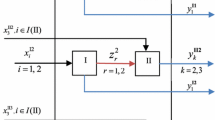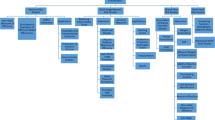Abstract
Performance evaluation of network production systems has been widely studied in recent Data Envelopment Analysis (DEA) literature where internal relations of sub-units are taken into consideration. Most of prior work assumes network systems to have simple series or parallel structures. Complexities of some practical production processes require development of DEA models for their effective analysis. However; input, intermediate products and/or output data are often stochastic and linked to exogenous random variables in most applications. The current study extends Malmquist Productivity Index (MPI) for investigating productivity changes of general network production units with stochastic data in a DEA framework. The proposed stochastic performance analysis models are then transformed into deterministic equivalent non-linear forms so they could be simplified to deterministic programming with quadratic constraints. Numerical examples including an application to productivity evaluation of branches of a university system are presented to illustrate the applicability of the proposed framework.


Similar content being viewed by others
Notes
Information and statistics collection system (https://stat.iau.ir/)
References
Charnes A and Cooper W W 1959 Chance constrained programming. Management Science 6: 73–79
Banker R D, Charnes A and Cooper W W 1684 Some methods for estimating technical and scale inefficiencies in data envelopment analysis. Management Science 30: 1078–1092
Emrouznejad A, Parker B and Tavares G 2008 Evaluation of research in efficiency and productivity: A survey and analysis of the first 30 years of scholarly literature in DEA. Socio Economic Planning Sciences 42: 151–157
Emrouznejad A and Yang G A 2018 survey and analysis of the first 40 years of scholarly literature in DEA: 1978–2016. Socio Economic Planning Sciences 61: 4–8
Kao C 2008 Efficiency measurement for parallel production systems. European Journal of Operational Research 196: 1107–1112
Kao C 2009 Efficiency decomposition in network data envelopment analysis: a relational model. European Journal of Operational Research 192: 949–962
Kao C and Hwang S N 2014 Multi-period efficiency and Malmquist productivity index in two-stage production systems. European Journal of Operational Research 232: 512–521
Kao C 2016 Malmquist productivity index for network production systems. Omega 4: 1–8
Kao C 2016 Measurement and decomposition of the Malmquist productivity index for parallel production systems. Omega 8: 18–25
Charnes A and Cooper W W 1963 Deterministic equivalents for optimizing and satisfying under chance constraints. Operations Research 11: 18–39
Charnes A, Cooper W W and Symonds G H 1978 Cost horizon and certainly equivalents: an approach to stochastic programming of heating oil. Management Science 4: 235–263
Cooper W W, Deng H, Huang Z and Li S X 2002 Chance constrained programming approaches to technical efficiencies and inefficiencies in stochastic data envelopment analysis. Journal of the Operational Research Society 53: 1347–1356
Cooper W W, Deng H, Huang Z and Li S X 2004 Chance constrained programming approaches to congestion in stochastic data envelopment analysis. European Journal of Operational Research. 155: 487–501
Lozano S 2011 Scale and cost efficiency analysis of networks of processes. Expert Syst. 38: 6612–6617
Kazemi Matin R and Azizi R A 2015 Unified network-DEA model for performance measurement of production systems. Measurement 60: 186–193
Cherchye L, De Rock B and Walheer B 2013 Multi-output efficiency with good and bad outputs. In: EJOR, pp. 1–26
Cherchye L, De Rock B and Walheer B 2015 Multi-output profit efficiency and directional distance function. In: OMEGA, pp. 1–37
Seiford L M and Zhu J 1999 Profitability and marketability of the top 55 US commercial banks. Management Science 45: 1270–1288
Lo S F and Lu W M 2006 Does size matter? Finding the profitability and marketability benchmark of financial holding companies. Asia-Pacific Journal of Operational Research. 23: 229–246
Kao C 2014 Efficiency decomposition for general multi-stage systems in data envelopment analysis. European Journal of Operational Research 232: 117–224
Kao C 2017 Network Data Envelopment Analysis. Springer. 10: 26–33
Kao C 2014 Network data envelopment analysis: a review. European Journal of Operational Research 239: 1–16
Caves D W, Christensen L R and Diewert W E 1982 The economic theory of index numbers and the measurement of input, output, and productivity. Econometrica 50: 1393–1414
Färe R, Grosskopf S, Lindgren B and Roos P 1989 Productivity developments in Swedish hospitals: A Malmquist output index approach. In: Socio Economic Planning Sciences pp 115–120
Walheer B 2018 Disaggregation of the cost Malmquist productivity index with joint and output-specific inputs. In: OMEGA, pp. 1–12
Walheer B and Zhang L 2018 Profit Luenberger and Malmquist-Luenberger indexes for multi-activity decision-making units: The case of the star-rated hotel industry in China. Tourism Management 69: 1–11
Färe R and Grosskopf S 2000 Network DEA. Socio Economic Planning Sciences 34: 35–49
Khodabakhshi M and Asgharian M 2008 An input relaxation measure of efficiency in stochastic data envelopment analysis. Applied Mathematical Modeling 33: 2010–2023
Khodabakhshi M 2009 Estimating most productive scale size with stochastic data envelopment analysis. Economic Modeling 26: 968–973
Khodabakhshi M, Jahanshahloo G R, HosseinzadehLotfi F and Khoveyni M 2012 Estimating most productive scale size with imprecise-chance constrained input–output orientation model in data envelopment analysis. Computers and Industrial Engineering 63: 254–261
HosseinzadehLotfi F, Jahanshahloo G R, Behzadi M H and Mirbolouki M 2011 Estimating stochastic Malmquist productivity index. World Applied Sciences Journal 13: 2178–2185
Ross A, KaanKuzu K and Wanxi L 2016 Exploring supplier performance risk and the buyer’s role using chance-constrained data envelopment analysis. European Journal of Operational Research 250: 966–978
Izadikhah M, Farzipoor Saen R 2018 Assessing sustainability of supply chains by chance-constrained two-stage DEA model in the presence of undesirable factors. Computer and Operation Research 3: 1–59
Färe R, Grosskopf S, Lindgren B, Roos P 1989 Productivity developments in Swedish hospitals: A Malmquist output index approach. Socio Economic Planning Sciences 14: 45–59
Yao X, ChengwenGuo G, Shuai Shao S and Zhujun J 2016 Total-factor CO2 emission performance of China’s provincial industrial sector: A meta-frontier non-radial Malmquist index approach. Applied Energy 184: 1142–1153
Aparicio J, Crespo-Cebada E, Pedraja-Chaparro F and Daniel Santín 2017 Comparing school ownership performance using a pseudo-panel database: A Malmquist-type index approach. European Journal of Operational Research 256: 533–542
Mohammad M and Saniee S 2013 Network DEA: An application to analysis of academic performance. Journal of Industrial Engineering International 9: 1–10
Fuentes R, Fuster B and Lillo-Bañuls A 2016 Three stage DEA model to evaluate learning teaching technical efficiency: Key performance indicators and contextual variables. Expert Systems with Applications 48: 89–99
Kuah C T and Wong K Y 2011 Efficiency assessment of universities through data envelopment analysis. Prodica Computer Science 3: 499–506
Despotis D K, Koronakos G and Sotiros D A 2015 Multi-objective programming approach to network DEA with an Application to the Assessment of the Academic Research Activity. Procedia Computer Science 55: 370 – 379
Acknowledgements
The authors are thankful to Editors and anonymous reviewers of Sadhana journal for their helpful comments and suggestions for improving the manuscript.
Author information
Authors and Affiliations
Corresponding author
Appendix A
Appendix A
To convert the chance-constrained optimization Model (4) to associate deterministic equivalent Model (5), we can proceed as follows. Note that the same argument could be presented for introducing Model (7). Here, \( \Pr \) means ‘Probability’ and \( \alpha \) is a predetermined value between 0 and 1.
The first constraint of Model (4) can be stated as follows:
By considering external slack value \( s_{i} \), we have:
So, there exist a positive slack variable \( s_{i} > 0 \) such that the above relation take this form:
Accordingly, by using the definition of expected value and variance of the elements, we may write the above equation as follows:
For the sake of simplicity let denote \( \sqrt {var\left( {\sum\limits_{{p \in P_{I} (i)}} {\sum\limits_{j = 1}^{n} {\lambda_{j}^{p} (\tilde{x}_{ij}^{p} )^{l} - \theta (\tilde{x}_{ik} )^{f} } } } \right)} \)by\( \sigma_{i} \left( {\theta ,\lambda } \right) \). Therefore, we have:
By denoting the left-hand side of the above inequality by \( z_{j}, \) it follows a normal standard distribution with zero mean and unit variance. Hence, we can write:
\( \Pr \left[ {z_{j} \ge \frac{{s_{i} - \sum\limits_{{p \in P_{I} (i)}} {\sum\limits_{j = 1}^{n} {\lambda_{j}^{p} (x_{ij}^{p} )^{l} + \theta (x_{ik} )^{f} } } }}{{\sigma_{i} \left( {\theta ,\lambda } \right)}}} \right] = \alpha. \) Thus, we have \( \varPhi \left[ {\frac{{ - s_{i} + \sum\limits_{{p \in P_{I} (i)}} {\sum\limits_{j = 1}^{n} {\lambda_{j}^{p} (x_{ij}^{p} )^{l} - \theta (x_{ik} )^{f} } } }}{{\sigma_{i} \left( {\theta ,\lambda } \right)}}} \right] = \alpha, \) where \( \varPhi \) represent the normal cumulative distribution function. So, taking the inverse, we obtain \( \left[ {\frac{{ - s_{i} + \sum\limits_{{p \in P_{I} (i)}} {\sum\limits_{j = 1}^{n} {\lambda_{j}^{p} (x_{ij}^{p} )^{l} - \theta (x_{ik} )^{f} } } }}{{\sigma_{i} \left( {\theta ,\lambda } \right)}}} \right] = \varPhi^{ - 1} (\alpha ), \) which could be stated as \( - s_{i} + \sum\limits_{{p \in P_{I} (i)}} {\sum\limits_{j = 1}^{n} {\lambda_{j}^{p} (x_{ij}^{p} )^{l} - \theta (x_{ik} )^{f} } } = \varPhi^{ - 1} (\alpha )\sigma_{i} \left( {\theta ,\lambda } \right) \)or equivalently as follows:
\( \sum\limits_{{p \in P_{I} (i)}} {\sum\limits_{j = 1}^{n} {\left( {\lambda_{j}^{p} (x_{ij}^{p} )^{l} } \right) - \varPhi^{ - 1} (\alpha )\sigma_{i} \left( {\theta ,\lambda } \right) \le \theta (x_{ik} )^{f} ,} } \quad i = 1, \ldots ,m. \) This is the first constraint of the model (5). The other constraints could be achieved in the same way.
For calculating \( \left( {\sigma_{i} \left( {\theta ,\lambda } \right)} \right)^{2} \) we can write:
Therefore,
In the model (5), \( \left( {\sigma_{i} \left( {\theta ,\lambda } \right)} \right)^{2} \) is denoted by non-negative variables \( (\omega_{i}^{l} )^{2} \).
Rights and permissions
About this article
Cite this article
HOSSEINI, S.S., KAZEMI MATIN, R., KHUNSIAVASH, M. et al. Measurement of productivity changes for general network production systems with stochastic data. Sādhanā 44, 72 (2019). https://doi.org/10.1007/s12046-018-1049-x
Received:
Revised:
Accepted:
Published:
DOI: https://doi.org/10.1007/s12046-018-1049-x




